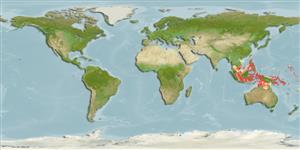>
Gobiiformes (Gobies) >
Gobiidae (Gobies) > Gobiinae
Etymology: Trimma: Greek, trimma, -atos = something crushed (Ref. 45335); cheni: Named for I.-S. Chen, National Taiwan Ocean University, Keelung, Taiwan.
Eponymy: Dr I-Shiung Chen is Director of the Institute of Marine Biology at the National Taiwan Ocean University. [...] (Ref. 128868), visit book page.
More on author: Winterbottom.
Environment: milieu / climate zone / depth range / distribution range
Ecología
marino demersal; rango de profundidad 5 - 52 m (Ref. 87358). Tropical
Western Pacific Ocean: Philippines, Indonesia. Recorded from Palau, the Philippines, and Sulawesi and Flores in Indonesia (Ref. 87358).
Tamaño / Peso / Age
Maturity: Lm ? range ? - ? cm
Max length : 2.2 cm SL macho / no sexado; (Ref. 87358)
Short description
Claves de identificación | Morfología | Morfometría
Espinas dorsales (total) : 6; Radios blandos dorsales (total) : 8 - 9; Espinas anales: 1; Radios blandos anales: 8. This species is distinguished from its congeners by having the following characters: 8-9 scales in the predorsal midline, 2-3 scales on the opercle, an elongate second dorsal spine reaching posteriorly to the bases of rays 1-4 of the second dorsal fin, middle pectoral fin rays branched, fifth pelvic fin ray branched once, a dark basal stripe in the dorsal fins, scale pockets indistinctly outlined with darker pigment, and, in life, two red to orange bars across the cheek and three diffuse yellow stripes on the body (most obvious along the caudal peduncle) (Ref. 87358); characterized further by longitudinal scale series 23; cheek without scales; moderately developed U-shaped interorbital furrow; depth of body about 3.6-4.0 in SL (Ref. 90102).
Occurs in outer reef slopes in 10-52 m (Ref. 90102).
Life cycle and mating behavior
Madurez | Reproducción | Puesta | Huevos | Fecundidad | Larva
Winterbottom, R., 2011. Six new species of the genus Trimma (Percomorpha; Gobiidae) from the Raja Ampat Islands, Indonesia, with notes on cephalic sensory papillae nomenclature. aqua, Int. J. Ichthyol. 17(3):127-162. (Ref. 87358)
IUCN Red List Status (Ref. 130435: Version 2024-1)
Threat to humans
Harmless
Human uses
Pesquerías: sin interés
Herramientas
Special reports
Download XML
Fuentes de Internet
Estimates based on models
Preferred temperature (Ref.
123201): 28 - 29.1, mean 28.6 °C (based on 106 cells).
Phylogenetic diversity index (Ref.
82804): PD
50 = 0.5000 [Uniqueness, from 0.5 = low to 2.0 = high].
Bayesian length-weight: a=0.01023 (0.00477 - 0.02194), b=3.01 (2.83 - 3.19), in cm total length, based on LWR estimates for this (Sub)family-body shape (Ref.
93245).
Fishing Vulnerability (Ref.
59153): Low vulnerability (10 of 100).
